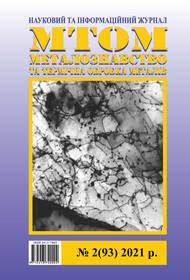Principles of certification of metals for susceptibility to brittleness by the criterion of critical strength
DOI:
https://doi.org/10.30838/J.PMHTM.2413.270421.48.740Abstract
Problem definition. Existing evaluation system of liability to brittle fracture is based on specifying the critical temperature Tc of ductile/brittle transition for specimens with stress concentrator (SC) and uses relative values of impact toughness (KCV, KCU) and widening (ψк). Thus the Tc becomes relative and it is not possible to measure brittleness or embrittlement degree for specimens with SC. Paper purpose. Neutralize the system faults of evaluation system of liability to brittle fracture of constructional alloys with SC. The concept is to change the KCV (KCU) or ψк parameters by critical strength parameter (ϭ0,2с at Tc). Conclusions. Fracture of the specimen with SC (ϭNF) on YTS (ϭ0,2с) at Tc (or room TR) as embrittlement criterion is proposed instead of relative values of (KCV, KCU) and (ψк). The ϭNF / ϭ0,2 = BrNF ratio is a degree of reliability for specimen with SC (BrNF > 1) or embrittlement measure (BrNF < 1). The BrNF value is a quantitative measure of the fracture resistivity of the specimen with SC or crack. Correlation ratio between Br and BrNF for each type of SC has been found. It allows to use the calculation of embrittlement liability based on metal strength for test of metals without full scale tests of metal specimens with SC.
Keywords: embrittlement; fracture degree; fracture resistivity; critical temperature; critical strength; strength
reliability of the specimen with SC

Downloads
Published
Issue
Section
License
Authors that are published in this journal agree to follow the conditions:
Authors reserve the right to the authorship of his work and cede the right to the journal of first publication of this work on conditions of the license under the Creative Commons Attribution License, which allows others to distribute it freely with the obligatory reference to the author of the original work and the first publication of the work in this journal.
